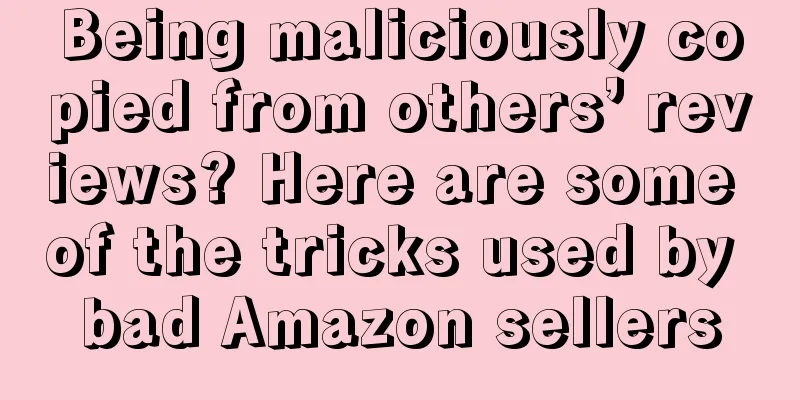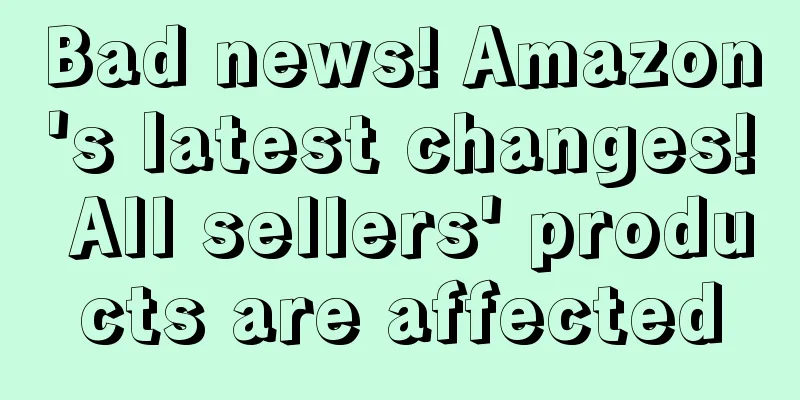Being maliciously copied from others’ reviews? Here are some of the tricks used by bad Amazon sellers

|
Amazon’s benefits are dwindling and the platform’s rules are becoming increasingly strict. However, there are more and more sellers and the competition is becoming more and more fierce. In this crowded scene, some unscrupulous sellers are blinded by profit and take malicious measures to attack their competitors. Today I will list down the harmful tricks that unscrupulous sellers have used over the years. Some people give themselves good reviews and some give their opponents bad reviews. Some people even give their opponents good reviews, but their reviews are too obvious and the platforms will find fault with you. Malicious sellers will create multiple new buyer accounts, not associated with the seller's account, and begin leaving negative reviews for competitors. The negative reviews may be about the condition of the product, that it does not work, or that it broke shortly after purchase. Once a review is posted, these sellers will often use other buyer accounts, even friends and family, to support the negative review, making it look real and causing other buyers to choose to buy from competitors out of concern for product problems, causing your sales to drop. It is impossible for any product to receive 100% positive reviews. There will always be sellers who give negative reviews. While some sellers try every possible way to have no negative reviews on their product homepage, some competitors will like those one-star reviews. They will use a large number of buyer accounts to click "Yes" under "Was this review helpful to you?" under Review until these reviews appear on the product details page. In this way, customers will only see one-star reviews when viewing the listing, which will affect the listing conversion and reduce the ranking. Some unscrupulous sellers will leave negative reviews and mention the product as "fire", "dangerous" or "hazardous" after purchasing the product, or directly complain to Amazon that the product is unsafe to use. These sensitive words can easily trigger Amazon's keyword algorithm robot review, resulting in the listing being closed. At this time, the seller can only restore the listing by submitting an action plan. Similarly, such complaints will seriously affect the ranking of the listing. We all know that Amazon buyer accounts can send emails directly to sellers without buying anything. Some bad sellers, with a large number of buyer accounts, can send 400-500 buyer messages to competitors in an hour or overnight. The emails usually contain some sensitive words: such as conterfeit, fake product, broken, exploded, fire, etc. After being captured by Amazon, the account will be warned at the least and blocked at the worst. Malicious competitors may buy up your inventory in large quantities or even buy out your inventory, and then return a large number or all of it around the return deadline, claiming that the product is inferior. In this way, you may get into trouble for returning too many products or violating the rules, and your inventory may not be used again for a month or more. During the period when your inventory is sold out, malicious sellers are likely to use your listing to resell the product, or sell it on other platforms such as eBay. Products that are not sold within a month will be returned to you due to various quality issues. In this way, they make a profit from the products sold and get back the principal from the products returned to you. Malicious clicks on ads will result in excessive clicks but no actual sales, which will reduce conversion rates and ultimately lead to a drop in rankings. In addition, invalid advertising fees will be incurred (Amazon will generally remove the advertising fees deducted for invalid clicks within 3 days). How to deal with malicious ad clicks: 1. Open a case and ask Amazon to help detect ad click IP, quality, etc. 2. It is best to conduct keyword advertising separately, opening 2-3 advertising groups for 1 ASIN to reduce the impact of a single advertisement on its product sales. Speaking of following others, it can be said that this is one of the most common means of competition. Some small sellers may just follow other sellers' products for convenience and trouble-free! They will follow other sellers' products when they see them selling well. Generally, this kind of following others often happens in the middle of the night, during the day, and back and forth, and they can't be driven away! What's more, some people follow others 24 hours a day! Amazon's rule of allowing copy-selling has caused many sellers to suffer. The most serious case of malicious copy-selling is that a seller's listing is copied by a large number of people and the seller's products are not shipped, resulting in buyer returns and bad reviews. For non-branded listings, bad sellers have many ways to hijack and manipulate listings: 1. By copying the sales, you send slightly different products to customers, increasing the probability of customers leaving low reviews and lowering the listing ranking. 2. By following the seller, a request to Amazon to modify the listing is sent, causing other sellers on the listing to sell products that are not the same as the ones listed, or by modifying the product title to add brand words, causing the listing to be reported. For the listings that you are following or are being followed, you must always check whether the pictures, titles, and descriptions have been modified, because any seller who follows can request Amazon to modify the listing, and it is the Amazon robot algorithm that reviews the modification request. Any platform has two sides, but Amazon's opportunities and risks are more polarized. As a third-party seller, you should properly control FBA inventory, operate multiple accounts, and operate multiple platforms to differentiate risks. Similar to the listing hijacking trick above, wholesaler (VC) accounts can edit the product details of products being sold by other sellers, ensuring that their products are displayed correctly. However, some sellers purchase these accounts on the black market and use this ability to change competitors' product pages and use irrelevant images to hurt their sales. A competitor may pull your product into its own product category, but in fact your product does not belong to that category, and your account may be suspended. However, Amazon’s existing “Other Categories” service will help victimized sellers defeat this conspiracy Another way to do this is to create a new listing in an existing category to sell your product, so there will be multiple different listings for the same product, but this is not in compliance with Amazon’s rules. Amazon will merge the various ASINs into one, so that everyone can be satisfied. Malicious sellers will buy a competitor's product and then go elsewhere to buy a cheaper version or a fake. When the genuine product arrives, they replace it with a cheaper product and claim that the product they received was not the real thing. They then return the fake product and keep the genuine product to sell. The scammer will then leave a review saying the product is fake, or file a complaint directly with Amazon. Either of these can result in an immediate suspension of the seller’s account, as Amazon takes counterfeit issues very seriously. Often, competitors will pretend to be the brand owner and complain that you are selling counterfeit goods or infringing products. Regardless of whether you are selling counterfeit goods or infringing products, if Amazon finds them, your listing will be removed from the shelves, and in serious cases, your sales rights will be directly removed. How to respond to a malicious warning complaint: 1. The best way is to register a trademark and complete brand registration, so that competitors cannot complain. 2. If you are complained of infringement without a registered trademark or brand record, you can first contact the product supplier to obtain relevant information on genuine authorization, such as the latest purchase invoice proving that the product comes from an authorized legal distributor. For example: If you are a seller on the US site, selling private-label products, using a generic trademark, but not registered with the US Patent and Trademark Office, you must be wary of malicious opponents registering your trademark. Competitors may deliberately buy your products and leave negative feedback, accusing you of selling fake or defective products. They complain to Amazon and attack you fiercely. In fact, Amazon doesn’t care what they say, but their words will trigger Amazon’s automatic processing system, and you will get a warning or your account will be directly frozen by Amazon. Use multiple accounts to push competitors off the front page of search results, or directly engage in price wars to bring down competitors. Some bad sellers use fake accounts to post free reviews in the review group, but then do not refund the buyers, resulting in a large number of returns! Serious listings will be removed from the shelves Unscrupulous sellers will check store information through links, and after checking, they will observe that your store has FBA and FBM LISTINGs, and submit refurbished LISTINGs, causing you huge losses! The specific operation method of competitors maliciously sabotaging them is that their peers first follow the sale of this type of goods, modify the attributes of the goods in the form of a table, deliberately add the attributes of adult products to the products, and select "TRUE", so that the Amazon system will think that the product is an adult product. In this case, the seller can change back the product attributes modified by the competitor, select the attribute of the product being an adult product as 'False', and the product listing can be restored. If that doesn't work, you can email the foreign team to resolve the issue completely. Opening a Chinese case will have little effect. Here are some suggestions for opening a case: First, provide the product ASIN to indicate the actual category of the product; Second, picture proof, such as invalid advertisements, inability to search in major categories on the front page, and other related screenshots; Third, text description, you can play the emotional card when necessary (For example, you will strictly abide by the rules of the Amazon platform) and your attitude must be firm (as an Amazon seller, if you encounter such situations frequently, it will seriously affect product sales, etc.) It means posting some deceptive and poor-quality questions and answers under other people’s normal LISTING, which interferes with buyers’ purchases and reduces conversion rates! Amazon does not allow multiple returns, inquiries, or negative feedback for the same product in one day. Once this happens, the seller’s listing will be restricted at best, and the account will be restricted at worst. A malicious seller can buy several products from you at the same time, and then return them all a day later for reasons such as "defective", "counterfeit", "not as described", etc. Amazon will not treat it as three products from the same order, but as three returns of the same product in one day. END |
Recommend
Useful tips! White hat methods to get high probability of winning Amazon flash sales!
Amazon’s on-site flash sales are a powerful tool f...
Many hot-selling products have been TROed, but Amazon still has a large number of links of the same products on sale!
Author | Ten Degrees@ Disclaimer | This article is...
West Coast port labor-management negotiations failed! The US supply chain may suffer a devastating blow!
<span data-docs-delta="[[20,"获悉,据外媒报道,国际仓储...
Question: Does the ST in the Amazon listing backend editing also involve brand infringement?
I can tell you from personal experience: the searc...
What is Lightning Technology? Lightning Technology Review
Qinglei Technology is the most professional cross-...
What is ESTONE? ESTONE Review
Shenzhen E-stone Technology Co., Ltd. (formerly kn...
Like Amazon! Walmart also provides welfare benefits for low-income people!
<span data-shimo-docs="[[20,"获悉,据外媒报道,近日沃尔...
Ultimate Guide: How to Sell Seasonal Products as an Amazon FBA Seller
Sellers, have you ever had such questions: Is it ...
Massive keyword "traffic pool" hit strategy, grasp the Prime Day traffic wealth
In order to grasp the Prime Day traffic and better...
What is Kuazhitong? Kuazhitong Review
Kuazhitong is the first cross-border intellectual ...
What is Zebra IoT? Zebra IoT Review
Zebra IoT is a logistics brand affiliated to Bangc...
When Amazon sellers register a new account and are being reviewed, please pay attention to the following points!
Every year, many Chinese sellers join Amazon, and ...
What is Haimaohui? Haimaohui Review
The Overseas Trade Federation (FTF) is a cross-bor...
Canadian rail workers strike ends! Logistics resumes operation
According to foreign media reports, Canadian Pacif...
Entering Walmart, an opportunity for Chinese sellers to reshuffle?
It is learned that on March 23, Kantar and NRF joi...









